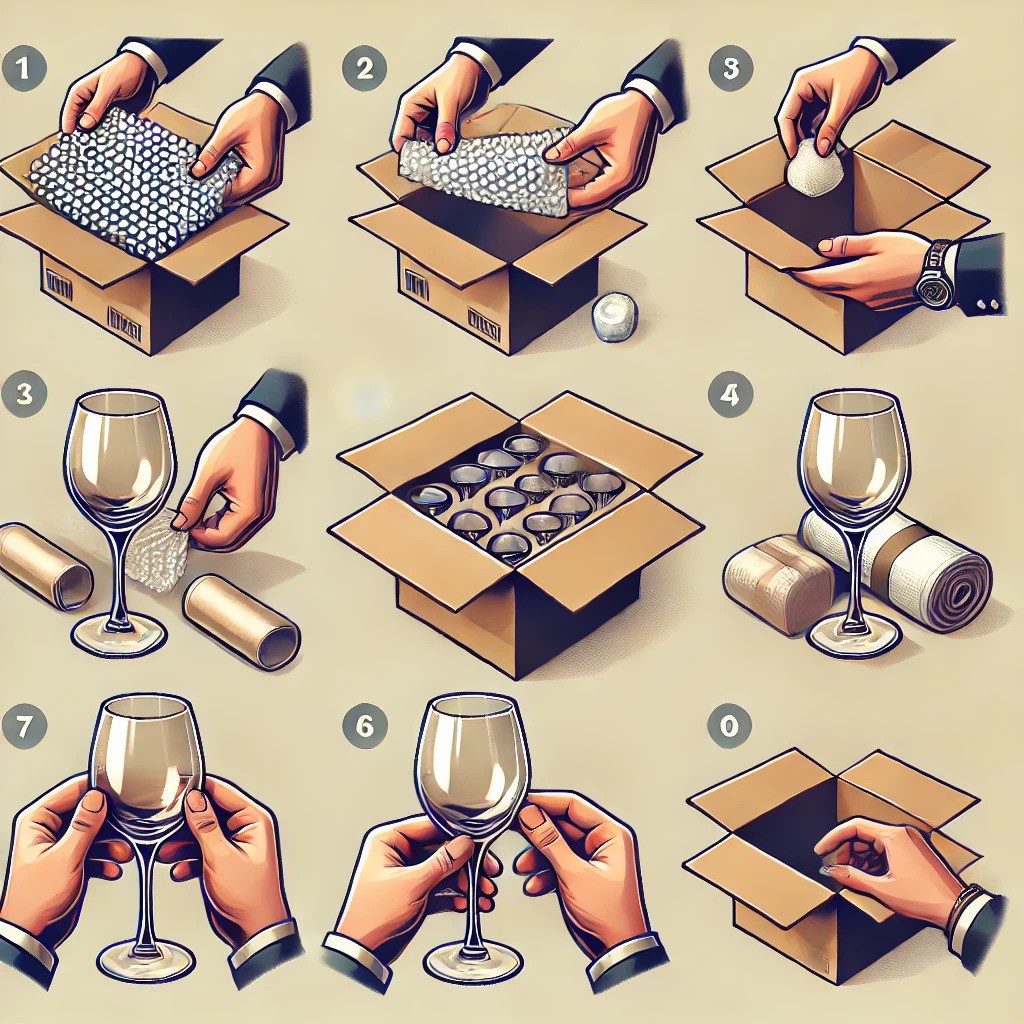Best Wrapping Materials & Tips for Fragile Items
Whether you’re moving to a different city, out of state or just across town some of your belongings need extra care to avoid damage. While you might choose to have a garage sale to get rid of items you don’t want to move, kitchen items like glasses usually come with you, as you’ll need them soon after you settle in.
Packing fragile items like drinking glasses and ceramic mugs is easier than it seems and can help prevent any breakage during the move. Here’s a simple guide on how to pack your glasses, mugs and cups so they arrive safely at your new place.
Before You Start
Choosing the Right Boxes
It’s a good idea to find gently-used boxes and packing materials as they can be reused multiple times. For packing mugs and glassware, opt for medium-sized boxes instead of large ones. Larger boxes can become too heavy and difficult to handle. A divided box with sections can also be useful but it’s not absolutely necessary.
Before you start packing, check the boxes carefully. Make sure the bottom is securely taped to avoid any accidents. The last thing you want is for your well-packed glassware to fall through the bottom of the box while moving.
Tip
You can ask liquor stores for boxes. These boxes are usually stronger than regular ones and can handle a lot of movement during the move without harming the items packed inside.
Packing Materials
For fragile items use packing paper, newspaper, bubble wrap or any soft material that can be wrapped around each glass or group of glasses. If you don’t have these, you can also use hand towels.
Keep in mind that bubble wrap is more expensive and harder to recycle. Free alternatives like old newspapers work just as well. However, if you use newspaper be aware that it might leave ink smudges, so you’ll need to wash your glasses after unpacking to remove the black ink.

What You’ll Need

Instructions
How to Pack Glasses When Moving

Start by placing the heaviest glasses at the bottom of the box and the lighter ones on top. Wrap each glass individually in packing paper or bubble wrap before placing it in the box. Add extra packing material beneath and on top of the wrapped glasses for added protection.
Prepare the Box
If you’re using packing paper or newspaper, crumple enough sheets to cover the bottom of the box. This cushioning will help protect the glasses from hitting the bottom and will also safeguard them if the box is dropped.
If you’re using towels make sure to create a thick layer at the bottom to protect the items from any impacts.
Wrap Large, Heavy Glasses
Start by wrapping and packing the biggest and heaviest glasses first. These should go at the bottom of the box with lighter glasses on top.
On a clean flat surface, lay out your packing paper or towels. Place a glass or mug at one corner of the packing material at an angle. Begin rolling it and as you roll, tuck the edges of the paper or towel into the opening of the glass. Continue wrapping until the glass is fully covered.
Wrap Stackable & Similar Glasses
Group glasses, cups and mugs by size. For smaller items you can cut packing paper or bubble wrap in half to save materials.
For glasses of the same size, follow the same wrapping method. After wrapping the first glass halfway, place a second glass next to it and continue wrapping both together. Tuck the ends of the paper into the openings.
For stackable glasses, place a thin layer of packing paper inside the first glass, then nest another glass inside. You can stack multiple glasses this way. Once stacked wrap the entire group with packing materials and tuck the ends inside the top glass.
Box Up the First Layer
Once your glasses are wrapped fold the ends tightly at the bottom of each glass to create a secure package.
At this point, you shouldn’t be able to feel the edges of the glass. If you still can, consider adding another layer of packing paper especially if the glass has a handle or a wide lip.
Fill the Box
Place the wrapped glasses in the box, starting with the larger, heavier ones on the bottom and the lighter ones on top. If you’re using a box with dividers slide the glasses into the sections. Add some packing material around them to keep everything snug and prevent movement during transport.
If there are no dividers arrange the wrapped glasses in rows making sure to add extra paper or bubble wrap between each one to avoid any breaking.
Pro Tip
If you have plastic cups, you can place wrapped glassware inside them. Some fragile items might fit perfectly into larger cups or tumblers giving them an extra layer of protection during the move.
Wrap Wine Glasses
To pack wine glasses start by wrapping the stem first. Use half a sheet of packing paper for the stem, then place the glass on more paper and roll it up completely. This way the most fragile part is well-protected.
Make sure to wrap each wine glass individually. These glasses should always be packed last, leaving extra space at the top of the box for additional cushioning.
Cushion the Top
Leave some space at the top of the box for more packing material. Once the box is nearly full add crumpled packing paper or bubble wrap on top.
You should add the same amount of cushion at the top as you did at the bottom. If you’re using towels or other soft materials, ensure there’s enough room for a thick protective layer on top.
Check & Seal the Box
Before sealing the box, gently shake it back and forth. You shouldn’t hear any glass clinking or feel much movement inside.
When you’re satisfied with the packing, seal the box with packing tape and label it. Note what’s inside and which room it belongs to. Also, mark the box as “Fragile: glassware” so movers handle it with care.
FAQs
How to pack glasses for moving without paper?
You can use soft items like towels, blankets or clothing to wrap your glasses. Just make sure each glass is wrapped individually and add extra layers between glasses for protection.
How to pack crystal glasses for moving?
Wrap each crystal glass in bubble wrap or packing paper then use soft items like towels or additional packing paper around them for extra protection. Make sure to pack them snugly in the box with plenty of cushioning.
How to pack glass baking dishes for moving?
Wrap each baking dish in bubble wrap or thick packing paper. Add extra padding around the edges and place them in the box on their sides to reduce the risk of breaking.
How to pack & move a grandfather clock?
To move a grandfather clock first remove any weights and pendulums and pack them separately. Use bubble wrap to protect the clock’s body then secure the entire clock in a sturdy moving box with extra padding.
How to pack wine glasses for moving?
Wrap the stem first with packing paper or bubble wrap then wrap the entire glass. Pack wine glasses at the top of the box with extra padding to prevent damage.
How to pack dishes & glasses for moving?
Wrap each item individually with packing paper or bubble wrap. Place heavier items, like dishes, at the bottom of the box and lighter ones, like glasses, on top. Use dividers if available and fill any gaps with packing material.
What is the Average cost of movers?
The cost of movers depends on factors like distance, size of the move and services required. On average, local moves can cost between $300 to $1,500, while long-distance moves might range from $2,000 to $5,000 or more.
How to pack glasses for moving with bubble wrap?
Wrap each glass completely with bubble wrap, making sure to cover all edges. Place heavier glasses at the bottom of the box and lighter ones on top. Add extra bubble wrap or other soft material to fill the spaces.
How to pack wine glasses for moving without dividers?
Wrap each wine glass individually, focusing on the stem. Place them at the top of the box with extra packing material between each glass to prevent movement during the move.
How to pack glass frames for moving?
Wrap each frame individually in bubble wrap or packing paper making sure to cover the corners well. Place them vertically in a box with additional packing material between each frame to prevent them from shifting.
How much should you tip movers?
A general guideline is to tip movers about 10-20% of the total moving cost or $4-$5 per hour per mover, depending on the level of service and the difficulty of the move.



